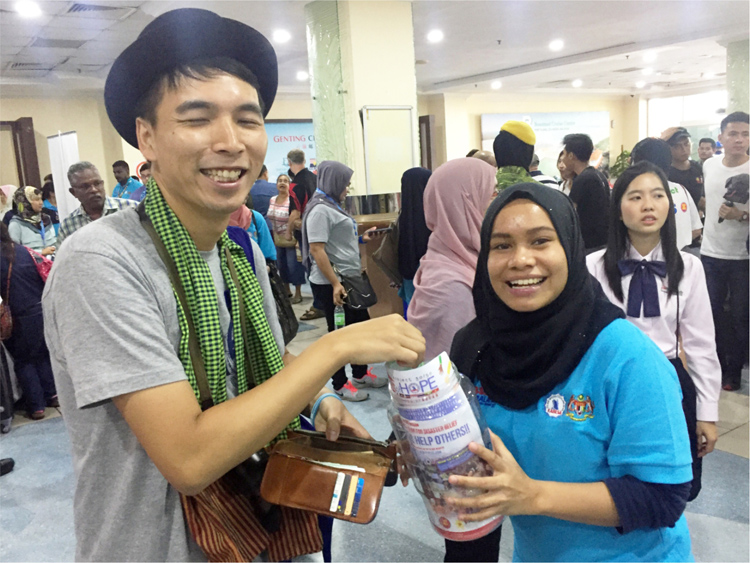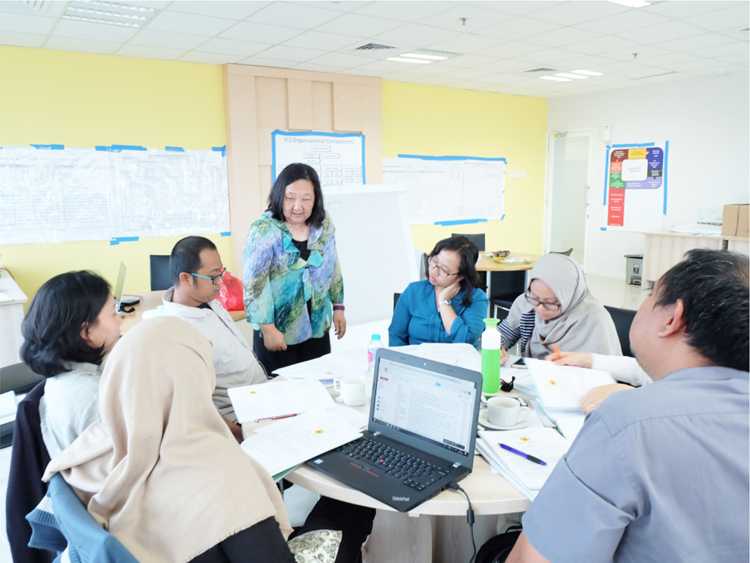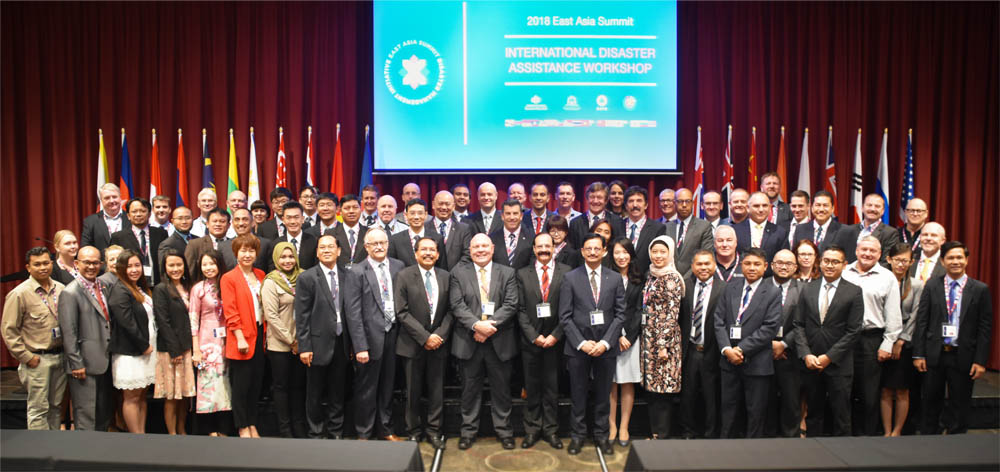Vol 37-Kit of Hope Fun Crowdfunding

KIT OF HOPE
FUN CROWDFUNDING
SUBANG, MALAYSIA, 5 MARCH 2018
Collaboration lies at the heart of One ASEAN One Response solidarity. Beyond a slogan, such solidarity asserts that every individual can contribute in the development of a collective resilience towards natural disaster. Alumnae of the Ship for Southeast Asian and Japanese Youth Programme (SSEAYP) in Malaysia demonstrated a similar spirit earlier this year, through a fundraising drive to support emergency response efforts in the region.
In late 2017, the SSEAYP Malaysia Chapter ran an independent crowdfunding campaign to celebrate the 50th anniversary of ASEAN, as well as the 45th year of cooperation between Japan and the ASEAN region. The campaign successfully secured funding to provide 10 thousand hygiene kits for the ASEAN standby relief stockpile – warehoused in Subang, Malaysia. Each hygiene kit comprises of sanitised wet wipes, shampoo, soap, face towel, toothbrush, sanitary pads, and a plastic comb. Not only did they fund the procurement of the relief items, members of SSEAYP International Malaysia also volunteered to pack the donations – that were handed over to the AHA Centre on March 5th, 2018.
“This is a good example of ASEAN solidarity where students raised money and contributed relief items in the spirit of One ASEAN One Response. It is an inclusive platform so everyone is welcome to join and contribute,” said Ms. Adelina Kamal, Executive Director of the AHA Centre.
SSEAYP was launched in 1974 by the Government of Japan to promote cross-cultural understandings between youth of all ASEAN Member States and Japan. The annual exchange programme allows participants to get to know each other through a two-month voyage on the Nippon Maru vessel.
“It was a great relief to see corporations, government agencies and ministries to also chip into the crowd-funding campaign. We had also received individual contribution from students and visitors of the Open Ship of SSEAYP in December 2017. But biggest applause is to the SSEAYP International members attending the Reunion on Board dinner, of which part of the tickets sold were routed to this effort,” said Dyana Abas, the Deputy President of SSEAYP International Malaysia, who was also the 20K Kit of Hope Program Chairperson.
Written by : Shintya Kurniawan | Photo: SSEAYP International Malaysia
- Published in AHA Centre Diary 2
Vol 38-Incident Command System and Incident Action Planning Workshops

INCIDENT COMMAND SYSTEM
AND INCIDENT ACTION PLANNING WORKSHOPS
JAKARTA, 16-27 APRIL 2018
During April 2018, the AHA Centre, with the support of the United States Forest Service (USFS), successfully conducted intensive trainings regarding the Incident Command System and Incident Action Planning.
The Incident Command System (ICS) model, first developed in the 1970s in the aftermath of wildfires in California and Arizona, encourages the use of a standardised management system to enable a synergised inter-agency collaboration when responding to an emergency. To date, ICS has been developed and adjusted to address various complexities and types of emergency responses, including during the first attack of the World Trade Centre in 1993. Alongside this, ICS is also applicable for managing non-emergency situations – such as public events which attract massive crowds – including sporting events, annual festivals, parades and concerts.
While ICS covers the basic principles of cross-sectoral coordinating mechanisms, Incident Action Planning (IAP) provides in-depth knowledge for the planning department of the AHA Centre whenever a need for disaster-response arises. The IAP trainings involved
case studies in which the AHA Centre’s staff were challenged to practice their skills, use their creativity, and draw on their knowledge to develop strategies to address various disaster scenarios, including landslides, floods, and fires. The evolving scenarios required continuous efficient response plans, factoring in analysis from available resources, logistical aspects, and also safety and security.
Both ICS and IAP have been adapted and utilised by the AHA Centre since its establishment as the coordinating agency for humanitarian assistance in Southeast Asian region. The dynamic nature of ICS has been effective for the Centre’s emergency operations, due to its flexibility and adjustability to suit a range of responses. The ICS system has also been adapted and is currently used by five ASEAN Member States, creating coordination and a common ground for the ever-growing regional collaborations in managing disasters.
Written by : Shintya Kurniawan | Photo : AHA Centre
- Published in AHA Centre Diary 2
Vol 39-EAS International Disaster Assistance Workshop

EAS INTERNATIONAL DIASTER ASSISTANCE WORKSHOP
OFFER GLIMPSES OF ASEAN’S COLLECTIVE RESPONSE THE REGION
PERTH, AUSTRALIA, 8-10 MAY 2018
The AHA Centre will be expected to play a crucial and pivotal role in facilitating ASEAN collective response beyond the Southeast Asian region, in particular to provide disaster assistance to non-ASEAN countries who are participating in East Asia Summit (EAS). This formed a key theme for discussion during the EAS International Disaster Assistance Workshop, held in Perth, Australia, from the 8th to the 10th of May 2018.
The workshop presented the participants with a scenario in which multiple disaster events strike Australia simultaneously. Despite the calculated low odds of the reality of such events occurring simultaneously, the scenario would severely stretch the existing disaster management system in Australia. Under this scenario, Australia will be forced to call for international assistance.
Participants engaged from different agencies within the Australian Federal Government, Local State Governments, as well as representatives from the ten ASEAN countries and other eight EAS participating countries (i.e. Australia, China, India, Japan, Republic of Korea, Russia, United States and New Zealand) to discuss the potential ramifications of this scenario. Points included Australia’s mobilisation of its internal resources and facilitation of international assistance, including the one from ASEAN.
The Southeast Asian region continues establish its roles and responsibilities within the global context – including within disaster management. ASEAN Leaders are in the process of repositioning themselves as a region with the capacity to provide disaster-related assistance to other regions in the world if required. This ambition is clearly stated in the ASEAN Declaration on One ASEAN One Response, signed by the ASEAN Leaders in September 2016. Therefore, the EAS workshop stands as a key initial step towards the goal of enabling ASEAN to respond collectively beyond the region. The AHA Centre, as the primary regional coordinating agency in disaster management, welcomed this opportunity to clarify the arrangements that must be in place to enable ASEAN in attaining the shared vision.
The workshop also represents the opportunity to partially test the EAS Disaster Response Toolkit developed by Australia and Indonesia in 2015. The Toolkit contains important information on how individual EAS participating countries may send and receive international assistance, as well as list of national focal points that could be contacted to arrange an offer of assistance. The workshop was co-hosted by Emergency Management Australia, the Government of Western Australia and the Indonesian National Disaster Management Agency Authority (BNPB), in close collaboration with the AHA Centre.
Written by : Dipo Summa | Photo: Emergency Management Australia
- Published in AHA Centre Diary 2






